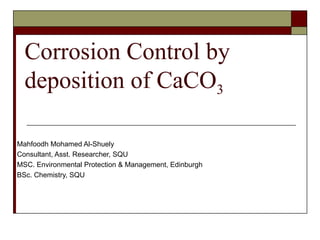Corrosion Control By Deposition Of Ca Co3
- 1. Corrosion Control by deposition of CaCO 3 Mahfoodh Mohamed Al-Shuely Consultant, Asst. Researcher, SQU MSC. Environmental Protection & Management, Edinburgh BSc. Chemistry, SQU
- 2. Contents What is corrosion Causes of corrosion Types of corrosion Prevention of Corrosion Proposed project
- 3. Corrosion Can be viewed as the process of returning metals to their natural state- the ores from which they are originally obtained Consists of a series of electrochemical reaction occurring at the metal surface in contact with water and its constituents
- 4. Corrosion 4Fe 2+ (aq) +O 2(g) +(4+2n)H 2 O (l) 2Fe 2 O 3 .nH 2 O (s) +8H + (aq) Rust
- 5. Causes of Corrosion Metals corrode because they oxidize easily Large difference in reduction potentials between oxygen and most metals causes oxides to be formed (rust) Microbes create areas with different concentration in oxygen, minerals and metals
- 6. Types of Corrosion General wastage of material- Uniform corrosion Galvanic corrosion-dissimilar metals in contact Pitting-localized attack Intergranular corrosion Stress corrosion Erosion-corrosion Corrosion fatigue High temperature oxidation Hydrogen embrittlement
- 7. Prevention of Corrosion Galvanizing- Zinc coating of steal Alloying- Chromium and Nickel coating to form oxides Corrosion inhibitor chemicals (carbonate, silicate, phosphates) Cathodic protection (most used in protecting buried pipelines and fuel tanks) Magnesium anode often used to furnish electrons
- 9. Proposed Project Altering certain parameters of water to force deposition of CaCO 3 CaCO 3 acts as a barrier between the metal surface and the water No addition of foreign elements in water nor altering metal properties Computer aided program predicts behaviour of protective film CHEAP
- 10. International Experience Recent studies published in Desalination (issue 213, 2007) about municipality of Hrysoypolis in Greece confirmed the benefits of CaCO 3 deposition in pipeline protection









